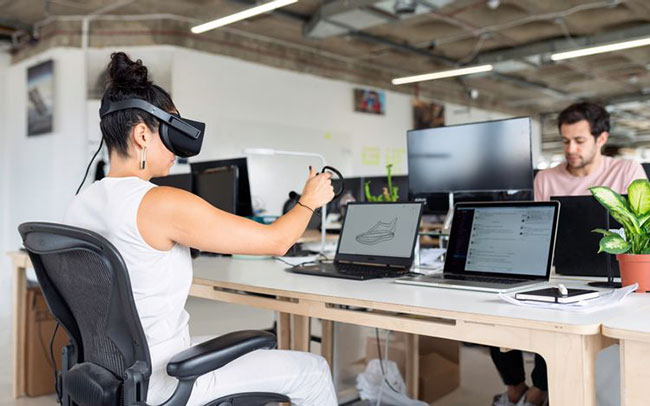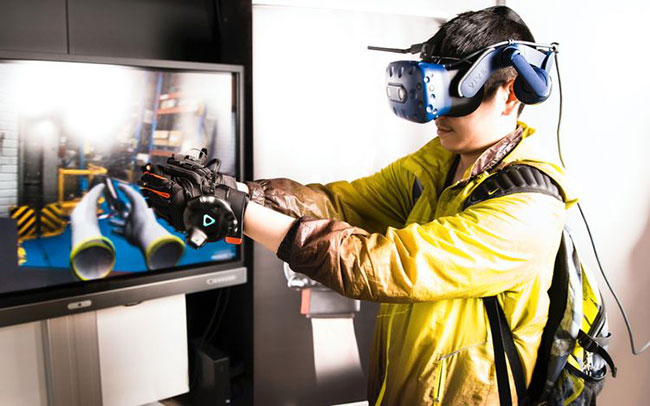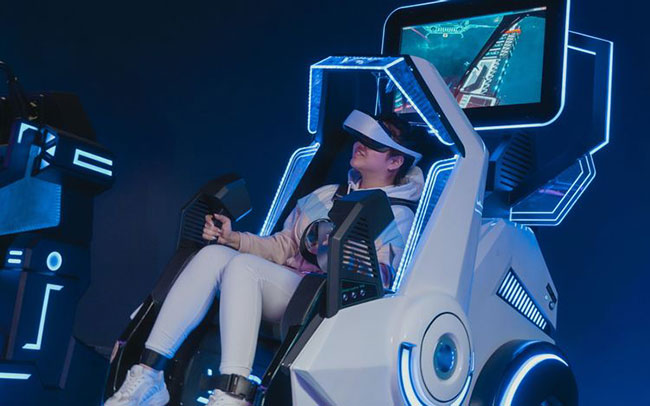What is Extended Reality (XR)? How does XR work?
Imagine what it would be like to live in a future world where virtual experiences are part of our lives.
In this article, let Tipsmake explore what XR is and outline its implications for the world.
What is Extended Reality (XR)?
XR refers to the use of augmented reality immersive technologies that fuse real and virtual worlds. XR is a term that combines virtual reality (VR), augmented reality (AR), and mixed reality (MR).
Virtual reality

Virtual reality (VR) allows you to interact in artificial three-dimensional environments using electronic devices like VR headsets, controller handles, and gloves. Oculus Quest 2, the VR multimedia entertainment system, is one of the most popular VR solutions on the market.
An example of a VR experience is through the game Batman: Arkham VR. The game takes you into a virtual world, where you feel like solving the mysteries of real-life criminals.
Augmented reality

Augmented reality (AR) describes the interactions between virtual experiences and the real world. It improves the real environment with images, animations or text. AR can be experienced through smart glasses, tablets and AR smartphones.
An example of an AR experience are Snapchat filters that add digital overlays - such as hats or glasses - to your photos. AR is the most widely adopted of all XR technologies. This is mainly because it requires the least amount of processing and functionality on most conventional devices.
Mixed reality

Mixed reality (MR) is a combination of VR and AR. It is aimed at filling the gap between the virtual world and the augmented world. MR combines both the digital and real worlds into one environment, so they coincide and interact with each other in real time. This can be experienced through MR headsets like the Microsoft HoloLens.
An example of the MR experience is integrating Microsoft's HoloLens with Skype. This experience allows you to make a Skype session look like an actual meeting.
Leading industries are transformed by XR technology
The XR market is growing rapidly. Here are the top industries transformed by XR technology:
Retail and marketing
The retail sector is getting smarter by allowing customers to try their products at home comfortably. WatchBox has adopted AR to offer its customers the privilege of trying out a virtual watch on their wrist. Swedish furniture company IKEA has launched the IKEA Place AR app. This allows customers to place virtual furniture into their homes using AR technology on their smartphones.
Education and training
XR allows people to be trained and educated in a secure, virtual environment without endangering their lives. Doctors, firefighters and pilots can simulate hazardous situations with minimal risk and less cost. The experience they have accumulated makes it easier to handle real situations.
For example, the US Marine Corps developed the AITT (Augmented Immersive Team Trainer) system, which was created using Microsoft's HoloLens MR headset. The system adds firepower and enemy effects in the virtual environment. This enhances your soldiers' combat performance and enhances their preparedness for real-world battles.
Real Estate
The XR solution allows real estate agents to take consumers to see virtual tours. Customers can explore the houses without having to come to see them live. Potential tenants or buyers can easily visit multiple locations and decide in-person places that are worth visiting in person.
Entertainment

The entertainment industry uses XR technology to provide consumers with a great experience. The XR enhances video games by immersing you in a virtual environment for an immersive experience. The XR can also help enhance other entertaining events such as live music exhibitions and performances.
Challenges in XR technology
XR technology developers are facing a number of challenges, including:
Data privacy issues
XR technology collects and processes detailed personal data. This could be data about what you do, what you see, and even how you feel. This could pose serious threats in the event that this data falls into the hands of cyber criminals. For this reason, XR technology developers face a major challenge of complying with all of the data protection requirements.
Cost
The cost of implementing XR technology is high, making it difficult for many companies to invest in it. AR technologies, like social media filters, are now inexpensive and accessible to any smartphone user. However, virtual and mixed reality technologies require relatively expensive equipment.
XR device design and development
The design of some XR devices presents many challenges for different users. For example, head-mounted VR and MR devices are often too heavy and uncomfortable to use over long periods of time. These devices are also known to cause eye fatigue and pain.
The development of XR technology is also in need of improvement. For example, Microsoft HoloLens can be controlled with gestures and voice commands. However, the gesture controls are limited to two hand movements.
The future of XR
Future XR devices will provide a seamless, personalized experience. These devices can allow you to comfortably access events in your home with an Internet connection. This will give you the same experience you would get from an actual concert or sporting event.
XR will allow outdoor (OOH) and mobile advertising to create super personalized ads. OOH digital displays will send you unique advertisements through sophisticated digital devices as you walk or drive through specific areas.
The coming years may see a new trend in creating virtual training simulation processes in response to climate crisis. XR will provide more interactive environmental education by creating virtual spaces where people can learn easily.
Users can also see the convergence of smartphones, mobile VR headsets, and AR glasses into a single wearable XR device. Such a device can replace all other screens like smartphones and smart TVs.
You should read it
- What's special about Apple's Vision Pro glasses costing $3,500 and how does it work?
- Invite Firefox Reality experience, the browser for virtual reality world
- Top 8 best virtual reality glasses 2018
- 4 development trends of virtual reality technology in 2019
- How to use VR virtual reality technology for iPhone?
- 9 best virtual reality apps for Android
- 6 key differences between Metaverse and virtual reality
- Virtual reality experience locations in Hanoi and HCM
May be interested
- Google Announces Android XR, a New OS Platform for AR and VR Glasses
 after years of neglect, google has finally decided to refocus its investment on extended reality (xr) devices like headsets and glasses.
after years of neglect, google has finally decided to refocus its investment on extended reality (xr) devices like headsets and glasses. - Top cheap quality virtual reality glasses
 virtual reality glasses are cheap, medium-range now, there are many, only about 1 million dong or less.
virtual reality glasses are cheap, medium-range now, there are many, only about 1 million dong or less. - Is virtual reality harmful to the eyes?
 spending a lot of time staring at screens can be harmful to your eyes, and using a virtual reality headset is no exception.
spending a lot of time staring at screens can be harmful to your eyes, and using a virtual reality headset is no exception. - Reveal the augmented reality glasses of Microsoft Research
 people will not be interested in new technology if they do not bring convenience, so that augmented reality (ar) is becoming more and more popular than virtual reality (vr).
people will not be interested in new technology if they do not bring convenience, so that augmented reality (ar) is becoming more and more popular than virtual reality (vr). - 12 super attractive AR apps for Android people
 enhancing virtual reality has become the trend on today's smartphones. take a look at the 12 best ar apps for android that you can try today.
enhancing virtual reality has become the trend on today's smartphones. take a look at the 12 best ar apps for android that you can try today. - Microsoft launched Sharepoint Spaces support mixed reality
 microsoft has unveiled their mixed reality vision when launching sharepoint spaces, enabling businesses to create a world of great experience, viewing sharepoint documents and documents.
microsoft has unveiled their mixed reality vision when launching sharepoint spaces, enabling businesses to create a world of great experience, viewing sharepoint documents and documents. - 5 cool, free virtual reality apps for iPhone
 did you know you can use google cardboard or other vr headsets with your iphone? while not as high-end as the oculus, these vr headsets are a fun way to experience vr without spending a fortune.
did you know you can use google cardboard or other vr headsets with your iphone? while not as high-end as the oculus, these vr headsets are a fun way to experience vr without spending a fortune. - Experience with 5 applications for virtual reality glasses
 have you ever believed a mobile phone can create a different experience? with virtual reality glasses, when watching a movie on a mobile phone, you absolutely can experience the feeling of watching movies in theaters with huge screens.
have you ever believed a mobile phone can create a different experience? with virtual reality glasses, when watching a movie on a mobile phone, you absolutely can experience the feeling of watching movies in theaters with huge screens. - Germany intends to spend 20 billion for the public computer system running Windows 7 to receive extended support
 the german government will pay at least 800,000 euro (about 20 billion vnd) in 2020 in exchange for the esu package for 33,000 payroll computers of government organizations.
the german government will pay at least 800,000 euro (about 20 billion vnd) in 2020 in exchange for the esu package for 33,000 payroll computers of government organizations. - Top 3 best virtual reality games
 virtual reality games make your entertainment experiences even more wonderful. this article introduces top 3 remarkable virtual reality games
virtual reality games make your entertainment experiences even more wonderful. this article introduces top 3 remarkable virtual reality games










 Signs that the VPN you are using is not reliable
Signs that the VPN you are using is not reliable What is the difference between HDR and 4K?
What is the difference between HDR and 4K? What is 51% attack? How does 51% attack work?
What is 51% attack? How does 51% attack work? How does WiFi work without a router?
How does WiFi work without a router? Instruction for mining Ethereum
Instruction for mining Ethereum What is DMP file? How to open DMP files in Windows 10
What is DMP file? How to open DMP files in Windows 10